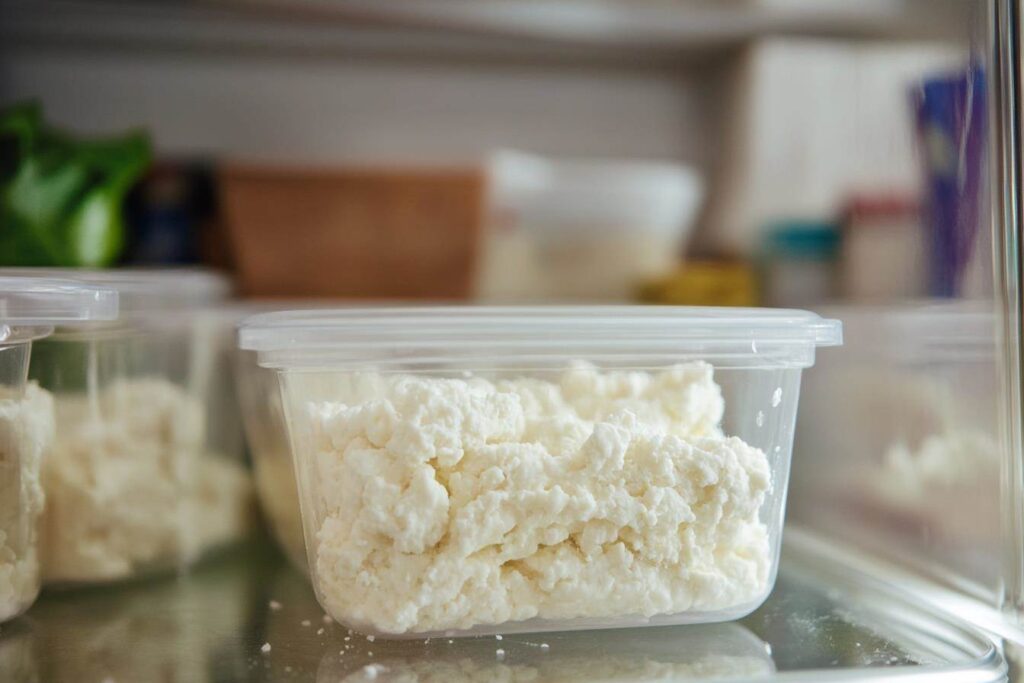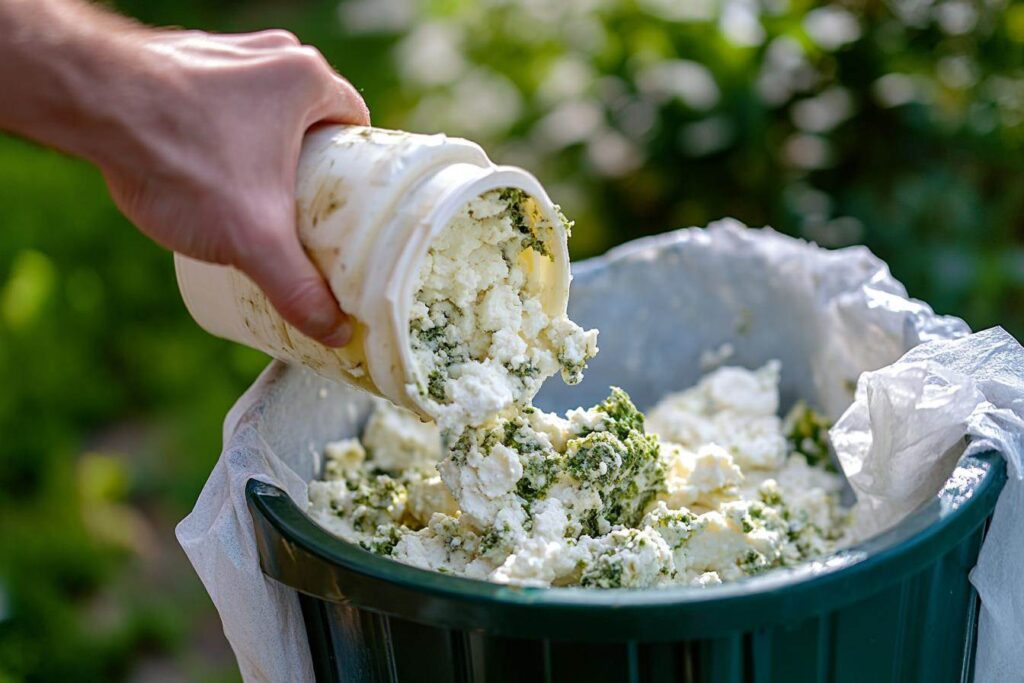Cottage cheese, known for its mild flavor and versatility, is a staple in many households. However, spoiled cottage cheese is not just unappetizing—it can pose serious health risks if not stored or handled correctly. This article explores how you can tell if cottage cheese has gone bad by identifying visible and hidden signs of going bad, understanding why it happens, and learning how to keep it safe to eat.
Introduction and Importance of Recognizing Spoiled Cottage Cheese
How Can You Tell If Cottage Cheese Has Gone Bad?
Cottage cheese is beloved for its creamy texture and subtle tanginess, but it’s not invincible to spoilage. The ability to recognize spoiled cottage cheese can save you from an unpleasant dining experience or even potential food sickness. Since bad dairy often carries harmful bacteria, knowing the signs of deterioration is not just about taste—it’s about your health.
Spoilage in dairy products, particularly in cottage cheese, can be subtle at first. Changes in texture, color, odor, and taste are common signs that something is amiss. Unfortunately, if you overlook these signs, consuming bad cottage cheese could lead to an array of uncomfortable symptoms, ranging from nausea to foodborne illnesses.
While proper storage and handling play a significant role in keeping dairy fresh, external factors like temperature and contamination can speed up the process. That’s why learning how to store and inspect your cottage cheese properly is crucial for every consumer.
With this knowledge, you’ll not only avoid wasting food but also safeguard your health. So, whether you’re a regular cottage cheese consumer or an occasional buyer, understanding how to spot and it from going bad is invaluable. Keep reading to dive into the specific signs of bad cottage cheese and ensure you never end up guessing again.
Common Signs That Cottage Cheese Has Gone Bad
Visual Indicators of Spoiled Cottage Cheese
Changes in Color
Fresh cottage cheese boasts a pristine, white and creamy appearance. This natural brightness is a key feature of its freshness. When fresh, its surface is free of blemishes or irregularities, reflecting its wholesome quality. But how can you tell if cottage cheese has gone bad? Visual cues often emerge as early warnings when spoilage begins to set in.
Discoloration is one of the most obvious signs. Spoiled cottage cheese may develop a yellowish tint, signaling the breakdown of fats and proteins. Even more alarming are mold spots—usually green, blue, or black—appearing on the surface or along the edges of the package. How can you tell if cottage cheese has gone bad when mold isn’t visible? Pay close attention to other signs, as mold is a definitive sign the product is no longer safe to consume.

Mold Formation
Visible mold on cottage cheese leaves no room for debate: it’s time to throw it out. Unlike some harder cheeses, which can sometimes have mold scraped off safely, soft dairy products like cottage cheese are highly porous. This means that mold’s roots can penetrate deep into the product, contaminating it beyond what you can see. Consuming even a small amount of moldy cottage cheese risks exposure to harmful toxins produced by the mold, such as mycotoxins, which can be dangerous to your health.
Changes in Texture
Clumping or Separation
Fresh cottage cheese has a smooth, consistent texture, characterized by its slightly curdled but well-blended curds. However, when it begins to spoil, the texture changes dramatically. You might notice excessive clumping, where the curds stick together unnaturally, making the product look lumpy or uneven.
Another common sign is watery separation. While a thin layer of liquid (whey) is normal and can be stirred back in, spoiled cottage cheese often produces excessive liquid, creating a soupy or uneven consistency. This separation is a clear indicator that the structural integrity of the cheese has deteriorated.
Slimy or Sticky Feel
Another red flag is a slimy or sticky texture. When bacterial growth escalates, the surface of the cottage cheese may develop a slimy film. If you notice this upon touching or stirring, it’s a surefire sign that bacterial activity has rendered the product unsafe to eat. Sliminess is not a characteristic of fresh cottage cheese, and it’s best to discard it immediately.
Odor and Taste Changes
Sour or Off Odor
The smell of cottage cheese is a reliable indicator of its freshness. But how can you tell if cottage cheese has gone bad just by its aroma? Fresh cottage cheese has a mild, slightly tangy scent, whereas spoiled cottage cheese develops a pungent and sour smell. This odor is often sharp and unpleasant, resulting from the fermentation of lactose and the breakdown of proteins.
Even if the texture or appearance seems normal, an off-putting odor is a clear sign that the cottage cheese is no longer edible. This is because harmful bacteria, such as Listeria or Salmonella, produce metabolic byproducts that affect the smell during spoilage.
Bitter or Strange Taste
Taste is another key factor in identifying spoiled cottage cheese, but it’s not advisable to taste it unless you’re absolutely sure it’s fresh. Spoiled cottage cheese often develops a bitter or strange flavor, markedly different from its usual mild taste.
If you notice bitterness, sharpness, or any unusual flavors, it’s best to avoid consuming it altogether. These taste changes are caused by the decomposition of fats and proteins, releasing byproducts that are not only unpleasant but potentially harmful.
Causes of Spoilage in Cottage Cheese
Factors Contributing to Cottage Cheese Going Bad
Improper Storage
Storage plays a critical role in keeping cottage cheese fresh. Refrigeration is essential because dairy products are highly perishable. Cottage cheese should always be stored at a consistent temperature of 4°C (39°F) or lower to inhibit bacterial growth.
Temperature fluctuations, such as taking the package in and out of the fridge frequently, can accelerate spoilage. Each time cottage cheese is exposed to warmer temperatures, even briefly, harmful bacteria have a chance to multiply. This can lead to noticeable spoilage or, worse, bacterial contamination before you even realize it.
Keeping the fridge clean and cold is equally important. A poorly maintained fridge may harbor bacteria that can quickly contaminate stored foods, including cottage cheese.
Expired Shelf Life
Like most packaged foods, cottage cheese comes with a “use-by” or “best-before” date printed on the package. While these dates are guidelines rather than guarantees, they give you an idea of how long the product is expected to remain at peak quality. Using cottage cheese past its use-by date can be risky, especially if the package has already been opened.
After opening, cottage cheese usually lasts 5–7 days, even if kept refrigerated. Beyond this time frame, the risk of spoilage increases significantly, as exposure to air and moisture creates an ideal environment for bacteria. While it might still look or smell fine for a day or two after the stated date, consuming it could lead to unpleasant side effects if spoilage is present but not yet visible.
Cross-Contamination
Cross-contamination is another common cause of cottage cheese going bad. Using dirty utensils to scoop out portions, for instance, can introduce harmful bacteria into the package. Similarly, allowing crumbs, food particles, or liquids from other items to mix with the cottage cheese can speed up its spoilage.
Another culprit is improper sealing. If the container is not tightly sealed, it can absorb odors and bacteria from other foods in the fridge. To prevent this, always use a clean utensil and transfer leftovers to an airtight container if the original packaging is damaged.
Risks of Consuming Spoiled Cottage Cheese
Health Risks of Eating Expired Cottage Cheese
Bacterial Infections
How can you tell if cottage cheese has gone bad and avoid the risks of consuming it? Spoiled cottage cheese poses a significant threat of bacterial infections. When cottage cheese goes bad, it becomes a breeding ground for harmful pathogens such as Listeria monocytogenes, Salmonella, and E. coli. These bacteria thrive in dairy products stored wrongly or when the cheese has exceeded its shelf life.
Listeria, in particular, is a serious concern for pregnant women, older adults, and individuals with reduced immune systems. It can lead to a condition known as listeriosis, which may cause flu-like symptoms or, in severe cases, complications such as meningitis. Similarly, Salmonella and E. coli can cause severe gastrointestinal distress and systemic infections, especially in vulnerable individuals.
Symptoms of Food Poisoning
Eating spoiled cottage cheese can result in food poisoning, with symptoms that often appear within hours or a few days after consumption. Common signs include nausea, vomiting, stomach pain, and diarrhea. In some cases, you might also experience fever, dehydration, or fatigue.
While most food sickness cases resolve within a few days, severe infections may require medical attention. Persistent symptoms, such as prolonged diarrhea or fever, can indicate a more serious issue, especially if caused by pathogens like Salmonella or E. coli.
Long-Term Risks
Risks for People with Compromised Immune Systems
For individuals with reduced immune systems—such as the elderly, infants, or those undergoing chemotherapy—the risks of consuming spoiled dairy products are even more pronounced. Bacterial infections from expired cottage cheese can escalate rapidly, leading to severe complications. In extreme cases, infections caused by Listeria can result in hospitalization or, even death.
Potential for Allergic Reactions
Spoiled cottage cheese may also trigger allergic reactions in some individuals. As the proteins and fats in the cheese break down, they can release compounds that are difficult for the body to process, leading to symptoms like rashes, swelling, or respiratory issues. While such reactions are rare, they highlight the importance of consuming only fresh, properly stored dairy products.
How to Store Cottage Cheese to Prevent Spoilage
Best Practices for Storing Cottage Cheese
Ideal Temperature for Storage
Proper refrigeration is critical for preserving the freshness of cottage cheese. This dairy product requires a consistent temperature to inhibit bacterial growth, which can cause spoilage. Ideally, cottage cheese should be stored at 4°C (39°F) or below.
Fluctuating temperatures, such as leaving cottage cheese out on the counter for extended periods, can harm its safety. But how can you tell if cottage cheese has gone bad due to temperature abuse? Even brief exposure to room temperature can accelerate spoilage, allowing bacteria to multiply rapidly. To ensure longevity, always return cottage cheese to the fridge immediately after use and verify that your fridge maintains a steady, cold environment.
Proper Sealing Techniques
Equally important to temperature is how the cottage cheese is sealed. While the original packaging is usually sufficient, transferring leftovers to an airtight container can enhance freshness. Airtight containers create a barrier against air and moisture, two culprits that speed up spoilage.
When sealing, ensure no part of the cheese is exposed to air, as this can dry out the curds and invite bacterial contamination. Always cover the package tightly, whether using a lid or plastic wrap, to maintain its texture and safety. Avoid using damaged or wrongly sealed packaging, as it raises the chance of contact with smells and germs from other foods in the fridge.
Tips for Extending Shelf Life
Use of Preservatives or Freezing Cottage Cheese
For long-term storage, consider freezing cottage cheese. While freezing may slightly alter the texture, it can significantly extend the shelf life, making it suitable for recipes where the texture change won’t be noticeable. To freeze, transfer the cheese to a freezer-safe, airtight container, leaving some space for swelling. Frozen cottage cheese can last up to three months, though it’s best used within two for optimal quality.
Some commercial brands may also include preservatives to enhance shelf life. If you’re buying preservative-free varieties, take extra care to store them properly to prevent food going bad.
Avoiding Contamination by Using Clean Utensils
Contamination is a leading cause of food going bad, so always use clean utensils when removing out cottage cheese. Introducing crumbs, liquids, or other food particles into the package can harm its quality and accelerate spoilage. If you’re unsure about a utensil’s cleanliness, err on the side of caution and wash it before use.

How to Properly Dispose of Spoiled Cottage Cheese
Safe Disposal Methods
Disposing of spoiled cottage cheese properly is essential to protect both your household and the environment. While it might be tempting to simply toss it into the trash, there are smarter, safer ways to handle it that reduce risks and environmental impact.
Tips for Safely Discarding Spoiled Dairy Products
When throwing away spoiled cottage cheese, avoid leaving it exposed in the trash where it can attract pests or release unpleasant odors. Instead, seal it tightly in its original package or a disposable plastic bag. If the packaging is damaged or leaking, double-bag it to prevent spillage. This simple step ensures that bacteria from the spoiled product doesn’t contaminate other items in your garbage.
For those with composting systems, it’s worth noting that dairy products, including cottage cheese, should generally be avoided in compost piles. They break down too slowly, emit strong odors, and may attract unwanted animals, making them unfit for typical composting setups.
Preventing Environmental Hazards by Proper Disposal
Spoiled dairy should never be poured down the sink or flushed. These actions can clog plumbing systems and contribute to environmental harm by introducing organic waste into waterways. Instead, always dispose of it with household waste, following local disposal regulations.
FAQs Your Questions About Spoiled Dairy Answered
Can you eat cottage cheese past its expiration date?
Yes, but with caution. How can you tell if cottage cheese has gone bad when it’s past its use-by date? Use-by dates, such as “use-by” or “best-before,” are guidelines for quality rather than absolute safety deadlines. If the cottage cheese looks, smells, and tastes normal, it might still be safe to consume a day or two after the printed date. However, always inspect it carefully for signs of food going bad, such as discoloration, unusual texture, or a sour odor. When in doubt, it’s safer to discard it.
What happens if you accidentally eat spoiled cottage cheese?
Eating spoiled cottage cheese can lead to symptoms of food sickness, such as nausea, vomiting, diarrhea, or stomach pain. If you experience mild symptoms, staying hydrated and resting usually suffices. However, if symptoms persist or worsen, especially for individuals with reduced immune systems, it’s important to seek medical attention promptly.
Can you freeze cottage cheese to extend its shelf life?
Yes, freezing cottage cheese can extend its shelf life by up to three months. However, freezing may alter the texture, making it less creamy and more crumbly. This works well for cooking or baking purposes but may not be ideal for fresh consumption. To freeze, place the cheese in an airtight container, leaving space for swelling, and thaw it in the fridge before use.
How long does opened cottage cheese last in the fridge?
Once opened, cottage cheese usually stays fresh for 5–7 days if stored properly in the fridge at 4°C (39°F) or below. To maximize freshness, keep it in its original package or transfer it to an airtight container. Avoid leaving it at room temperature for extended periods, as this can encourage food going bad.
Does mold mean all of the cottage cheese is bad?
Yes, mold on cottage cheese means the whole package should be thrown away. Unlike hard cheeses, where mold can be removed, soft dairy products are porous, permitting mold to spread unseen. Consuming moldy cottage cheese can expose you to harmful toxins.
Why does my cottage cheese smell sour before the expiration date?
A sour smell before the expiration date can result from improper storage or transportation. If the cheese was exposed to temperature fluctuations or contamination during handling, spoilage may occur earlier than expected. Always store cottage cheese at consistent refrigeration temperatures to maintain freshness.

Summing Up: Keeping Cottage Cheese Fresh
Cottage cheese is a versatile and nutritious addition to many meals, but its freshness is vital to both taste and safety. How can you tell if cottage cheese has gone bad before consuming it? Recognizing the signs of going bad, such as changes in color, texture, odor, or taste, is essential to avoid the risks associated with consuming spoiled dairy.
Preventing food going bad begins with proper storage. Refrigerating cottage cheese consistently at or below 4°C (39°F) and sealing it tightly in its original packaging or an airtight container can significantly extend its shelf life. For long-term storage, freezing is an effective option, though it may slightly alter the texture. Always use clean utensils to prevent cross-contamination, and never ignore the “use-by” date as a general guide for freshness.
Ultimately, food safety should always come first. Spoiled cottage cheese not only ruins a good meal but also poses serious health risks, especially for vulnerable individuals.

